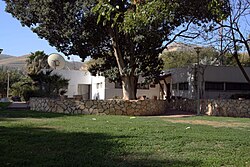Masua מַשּׂוּאָה | |
|---|---|
 | |
| Coordinates: 32°06′48″N35°29′33″E / 32.11333°N 35.49250°E | |
| District | Judea and Samaria Area |
| Council | Bik'at HaYarden |
| Region | West Bank |
| Affiliation | HaOved HaTzioni |
| Founded | 1969 |
| Founded by | Nahal |
| Population (2023) [1] | 434 |
Masua (Hebrew : מַשּׂוּאָה, lit. Torch, Arabic : مسواه), also transliterated as Massu'a, is an Israeli settlement organized as a moshav shitufi in the West Bank. [2] Located in the Jordan Valley, with an area of 6,000 dunams, it falls under the jurisdiction of Bik'at HaYarden Regional Council. [2] In 2023 it had a population of 434.
Contents
The international community considers Israeli settlements in the West Bank illegal under international law, but the Israeli and US governments dispute this. [3]
